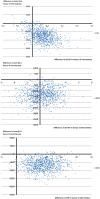Pain Exposure Physical Therapy versus conventional treatment in complex regional pain syndrome type 1-a cost-effectiveness analysis alongside a randomized controlled trial
- PMID: 29430970
- PMCID: PMC5971370
- DOI: 10.1177/0269215518757050
Pain Exposure Physical Therapy versus conventional treatment in complex regional pain syndrome type 1-a cost-effectiveness analysis alongside a randomized controlled trial
Abstract
Objective: To analyze cost-effectiveness of Pain Exposure Physical Therapy compared to conventional treatment alongside a randomized controlled trial (NCT00817128) in patients with complex regional pain syndrome type 1, where no clinical difference was shown between the two groups in an intention-to-treat analysis.
Design: Randomized controlled trial with 9 months follow-up.
Setting: Patients were recruited from hospitals and general practitioners in the region around a university hospital.
Subjects: A total of 56 patients, 45 (80.4%) female, were randomized. About 4 patients in the intervention and 11 patients in the conventional group switched groups. The mean (SD) age was 44.3 (16.6) years, and in 37 (66.1%) patients, the upper extremity was affected.
Interventions: Patients received either Pain Exposure Physical Therapy (maximum of five sessions), or conventional treatment conforming with the Dutch multidisciplinary guideline.
Main measures: For the economic evaluation difference between the groups in health-related quality of life (quality-adjusted life years (QALYs)), and the clinical outcomes Impairment level Sum Score-Restricted Version and Pain Disability was determined based on the intention-to-treat analysis as well as differences in both healthcare-related costs and travel expenses. Cost-effectiveness planes were constructed using bootstrapping to compare effects and costs.
Results: No significant effects were found for QALYs (mean difference = -0.02; 95% confidence interval (CI) -0.10 to 0.04) and clinical outcomes. A cost minimization analysis showed a significant difference in costs between groups. The conventional treatment was 64% more expensive than the Pain Exposure Physical Therapy.
Conclusion: This economic analysis shows that Pain Exposure Physical Therapy compared to conventional treatment is cost-effective.
Keywords: Physical therapy; complex regional pain syndrome; cost-effectiveness; randomized controlled trial.
Conflict of interest statement
Figures
References
-
- De Rooij AM, Perez RS, Huygen FJ, et al. Spontaneous onset of complex regional pain syndrome. Eur J Pain 2010; 14(5): 510–513. - PubMed
-
- Bruehl S, Harden RN, Galer BS, et al. External validation of IASP diagnostic criteria for Complex Regional Pain Syndrome and proposed research diagnostic criteria. International Association for the Study of Pain. Pain 1999; 81: 147–154. - PubMed
-
- Vlaeyen JW, Linton SJ. Fear-avoidance and its consequences in chronic musculoskeletal pain: a state of the art. Pain 2000; 85(3): 317–332. - PubMed
-
- De Jong JR, Vlaeyen JW, de Gelder JM, et al. Pain-related fear, perceived harmfulness of activities, and functional limitations in complex regional pain syndrome type I. J Pain 2011; 12(12): 1209–1218. - PubMed
Publication types
MeSH terms
LinkOut - more resources
Full Text Sources
Other Literature Sources
Medical



